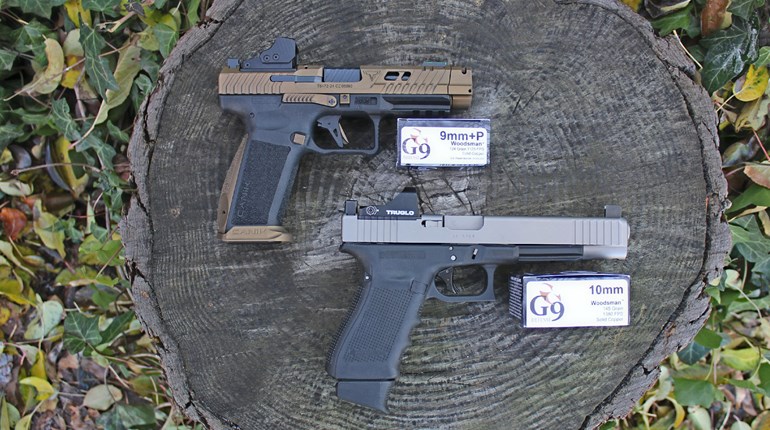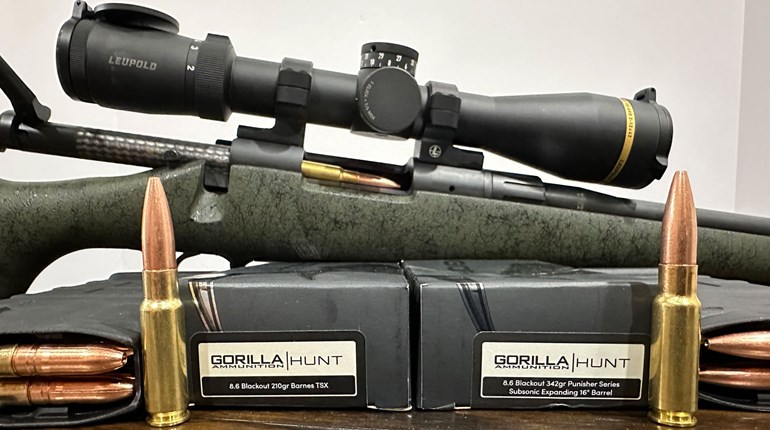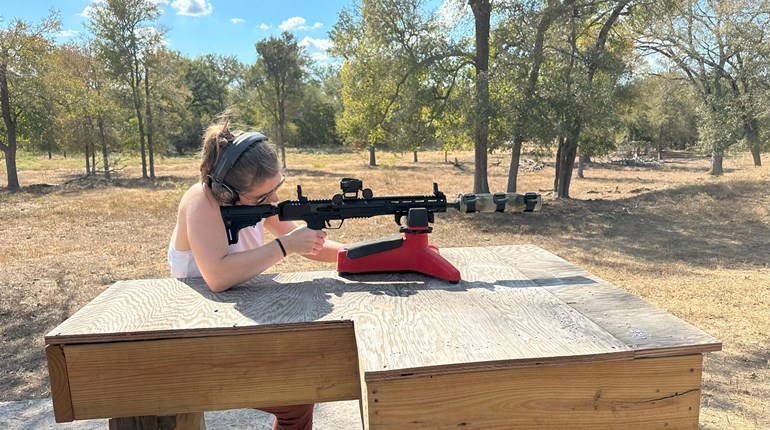
So far, everything in this series has been rifle rounds. This time, we’re going to look at two cartridges that arguably perform best from barrels less than 16 inches. Not only that, but we’re swinging for the fences with the biggest of the big-bores: the .50-calibers. We’re looking at what most would say is the king of the hand cannons, the .500 S&W Magnum, and comparing it to the often-forgotten but largest AR-15 cartridge ever conceived, the .50 Beowulf.

“That’s a rifle round!” When it was launched, that was true. However, many cartridges now function ideally from much shorter barrels thanks to modern bullets and powders. What’s more, short-barreled ARs make for some of the best hunting guns because they fit in tight spaces like blinds and tree stands. Even out West, when hunting dark timber or in thick brush, a short, compact firearm can make a world of difference. That’s the premise of the argument here: ballistically they’re nearly identical, but as the data below shows, it’s not so much the ballistics of the .50 Beowulf that are impressive by comparison, it’s the .50 Beowulf’s platform that gives it the edge. However, one note on an interesting “cool” factor regarding the .50 Beowulf: Alexander Arms’ reloading data claims Power Belt projectiles—yes, the projectiles used for muzzleloaders—can be used in the .50 Beowulf cartridge if the plastic belt is removed prior to loading. This opens up the Beowulf to even more bullet options aside from the variety of projectiles already available from Hornady, Barnes, Lehigh Defense, Sierra and probably a couple others.

So, the big question is: How does the .50 Beowulf’s performance stack up against the .500 S&W Magnum? Hornady and Lyman reloading manuals are the only resources I’ve found which list data for both cartridges for the fairest, apples-to-apples comparison (for the best bang for your buck, handloading is going to be your best option in either case). Using the two most common powders (both reloading manuals list data for H110 and Lil’ Gun), there are three basic bullet weights fired in each of these cartridges: 300-, 350- and 500-grain bullets. That’s not to say there’s no other data from other reloading books available, but for the sake of equal comparison when looking at unique cartridges like this series does, it’s the best way to assess performance. There are a few important disclaimers Lyman makes about its reloading data. First, per the Lyman manual, “We used Starline brass designed for large rifle primers to develop this data. Do not use cases designed for large pistol primers with this data. Starline brass designed for large rifle primers has an “R” after “Mag” on the headstamp to designate a large rifle (primer) pocket.” Secondly, Lyman notes a max load of H110 for the 350-grain bullet gave the most potential accuracy for that bullet weight. Finally, for whatever reason, though both cartridges use true .50-caliber bullets, as shown, there is no data for 350- or 500-grain bullets in the Lyman reloading manual for .500 S&W Mag. Without further ado, here’s a breakdown of the data:


In my real-world ballistic testing of the .50 Beowulf, while the cartridge is intended for rifle-length (16-inch) barrels, it doesn’t lose much when fired from shorter barrels, even those of pistol or SBR lengths. I chronographed a 325-grain load from a 12-inch barrel for testing purposes. Based on Alexander Arms’ advertised velocity of 1,700 fps for the .50 Beowulf using a 300-grain bullet fired from a 12-inch barrel, the 325-grain bullet came up 100 fps short, at 1,600 fps out of the same 12-inch barrel. So, the difference is negligible, especially when hurling a 300- or 325-grain bullet at those speeds. What’s more important to consider is the .50 Beowulf’s 325-grain load carries 8.3 percent more weight and only lost 6.8 percent of its velocity compared to the 300-grain load. The 325-grain bullet from the 12-inch barrel was travelling roughly 200 fps slower than the 300-grain load fired from a 16-inch barrel, which is a win when pushing a bullet with nearly 10 percent more weight from a barrel 25-percent shorter.

Compare all that to the .500 S&W Mag. Using the 300-grain data for consistent reference once again, the 1.600 fps, 325-grain .50 Beowulf load from a 12-inch barrel doesn’t stack up too badly against the .500 S&W Mag. Alexander Arms lists 325-grain data at essentially 2,000 fps with Lil’ Gun powder, and 1,850 fps with H110 (barrel length isn’t listed, but I’m assuming this is from a 16-inch barrel). This puts it right up there with the .500 S&W Mag. Looking at other options from Alexander Arms’ data for the .50 Beowulf shows the same 350-grain bullet from two different manufacturers (Sierra Bullets and Hornady) both traveling at 1,850 fps from a max load (35.4 grains) of Lil’ Gun, which is 200 fps faster than the S&W load from Hornady using the same powder, which also uses nearly 10 more grains—or 16.4-percent more powder, to be exact—of Lil’ Gun when compared to the load data for the Beowulf from Alexander Arms. Again, this is most likely from a 16-inch barrel in the Beowulf’s case, which is about twice as long as the barrel used in the Hornady data for .500 S&W, so it’s going to lose some; the point is, across the board, barrel length being equal, the two cartridges are about on par with one another. As shown, the velocities between cartridges are pretty close, so shooters won’t be at a loss when selecting either cartridge.

What the .50 Beowulf on the AR-15 platform brings to the table when compared to the .500 S&W Magnum and its revolver or lever gun is where things get interesting, and why the firearm platform is the tiebreaker (Hint: the AR-15 in .50 Beowulf wins, hands down). With the AR-15 offering, magazine capacity is increased, not to mention .50 Beowulf cartridges run fine in standard AR-15 magazines (I’ve got several loaded up in PMAGs and standard metal GI magazines alike). The pace at which those fresh rounds can be fired is also increased, and there’s less fatigue in recoil when shooting a heavier gun, especially when fired against the shoulder—which is a much more immovable, sturdy and durable body part—rather than a wrist from a handgun. The AR-15 also offers a much more customizable firearm because lights, lasers, thermals, range finders, back-up sights … you name it, can be mounted on an AR-15. Further, because most AR-15 barrels are threaded, once velocity slows down enough at the 500-grain bullet weights and up, a suppressor can be used to great effect. Sure, you can pay a machine shop or a gunsmith to thread your lever-action or revolver barrel, but then that ups the cost you need to put into the gun, which is already significantly more than simply buying an upper for the AR-15 lower you likely already have.

Lastly, one quick caveat. Some of you may be wondering why I selected the .50 Beowulf over the .500 Auto Max. The answer is twofold: one, there’s far more reloading data and components, as well as loaded ammo available for the .50 Beowulf; two, the .500 Auto Max cartridge runs through an AR-10 receiver rather than an AR-15 receiver, meaning it’s heavier and longer. And let’s be honest, the .50 Beowulf is already a niche round as it sits; there’s no need to compound the issue by having to trim the rim of a .500 S&W Mag. Based on a quick search of Midwayusa.com, there are twice as many ammo offerings available from manufacturers for the .50 Beowulf compared to the .500 Auto Max, and it’s all at a cheaper cost. Granted, there are nearly four times as many ammo options available for the .500 S&W Mag. as the .50 Beowulf for about the same price.

There you have it. The only thing gained when shooting the .500 S&W over the .50 Beowulf is the .50-caliber handgun aspect, and as “cool” as it sounds, it’s not as cool to shoot. All the benefits of the AR-15 platform are lost.

































